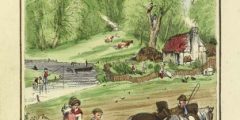Beyond the Sunken Garden: The Many Lives of Lenton Hurst
July 22, 2025
Lenton Hurst is best known for its peaceful formal gardens, but there’s much more to this late Victorian delight: in its long life it has been a home, a college, a student hall of residence and an office, and many of its original features still survive… The land where Lenton Hurst stands today was purchased …
Hugh Stewart Hall: from Marlepitt to Manor House
July 15, 2025
Today, Hugh Stewart Hall is concealed in a wooded hollow, accessible by a winding path leading through an iron pergola covered in climbing plants and past the old tennis courts to the garden, where the story of this remarkable property began. The east side of the garden was once a ‘marlepitt’, according to 16th century …
Thoresby’s Lady Rozelle: the Nottinghamshire landowner who loved the open ocean
July 8, 2025
Lady Rozelle Raynes, born Frederica Rozelle Ridgway Pierrepont, had a long life (1925-2015) of chance, tragedy, adventure and happiness. Her parents were Gervas Evelyn Pierrepont and Marie-Louise Roosevelt Butterfield. They were privileged but not titled. Gervas fought with distinction in the First World War and then became a London County Councillor. Marie-Louise’s father had inherited …
Outreach Diary
June 26, 2025
Here at MSC, our outreach calendar is always bursting with a wide range of events, visits and classes– here’s just a snapshot of a few highlights from the year so far… First up, we were proud to co-host the module ‘Exploring the German Archive’ alongside the School of Modern Languages and Cultures! Across 10 sessions, …
Maurice William Partridge: Chemist and Accomplished Artist
June 17, 2025
This is a guest blog by Tinashe Chipawe, a Conservation student who completed a placement with Manuscripts and Special Collections in 2025, working on the records of the Maurice William Partridge. When I first encountered the Maurice William Partridge Collection during my conservation placement at the University of Nottingham’s Manuscripts and Special Collections, I was …
The Beginnings of University Park
May 22, 2025
Did you know that University Park was originally intended to be a ‘model village’ rather than a university? Prominent industrialist Sir Jesse Boot purchased the Highfields estate in 1919, with the initial idea of transforming it into an attractive self-contained suburb to house Boots employees. However, around the same time, he had been engaging in …
The British Cotton Growing Association
May 13, 2025
This is a guest blog by Alejandra Ponce Martorell, an undergraduate student who completed a Conservation placement with Manuscripts and Special Collections in 2025 working on the records of the Cotton Research Corporation. The cotton collection contains the papers and library of printed material of the British/Empire Cotton Growing Corporation. Founded in 1902, the corporation …
On the Land
April 24, 2025
In celebration of our new exhibition, ‘Country Lives: Exploring the English countryside from 1800’, today we’re sharing a selection of items from our collections which can give us insight into how the countryside has been used and depicted in the past… Many documents recording property holding and the changing use of land over the centuries …
Life in 19th century Ethiopia
April 2, 2025
One of the most famous 19th-century travellers who makes an appearance in our collection is Mansfield Parkyns (1823-1894). Parkyns, a younger son of Sir Thomas Parkyns of Bunny Hall, Nottinghamshire, decided to leave England abruptly aged 19 in 1842 without making his family aware of his plans, or keeping them updated regarding his whereabouts… His …
Through the Lens: A Victorian Travel Album
March 19, 2025
Following on from our previous blog, which unravelled the mystery surrounding a collection of 19th century slides depicting buildings and landscapes in India, this week we’re exploring another collection of Victorian photographs, following in the footsteps of Carrie S. North as she travels around France, Monaco, Algeria and Italy in 1891… Unfortunately, very little is …










